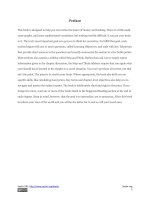Money and Banking: Lecture 12
Bạn đang xem bản rút gọn của tài liệu. Xem và tải ngay bản đầy đủ của tài liệu tại đây (290.43 KB, 20 trang )
Money and Banking
Lecture 12
Review of the Previous Lecture
• Measuring Risk
• Variance and Standard Deviation
• Value At Risk (VAR)
• Risk Aversion & Risk Premium
Topics under Discussion
• Sources of Risk
• Idiosyncratic
• Systematic
• Reducing Risk Through Diversification
• Hedging Risk
• Spreading Risk
• Bond and Bond Pricing
How to Evaluate Risk
• Lets go back to our previous example
where $1,000 yields either $1,400 and
$700 with equal probability
• If we think about this investment in terms
of gains and losses, this investment offers
an equal chance of gaining $400 or
loosing $300
• Should you take the risk?
How to Evaluate Risk
Evaluating the Risk of a $1,000 investment
A. The Gain
Payoff
Probability
+ $400
½
$0
½
B. The Loss
Payoff
Probabilities
$0
½
- $300
½
How to Evaluate Risk
•
Deciding if a risk is worth taking
1.
2.
3.
4.
List all the possible outcomes or payoffs
Assign a probability to each possible payoff
Divide the payoffs into gains and losses
Ask how much you would be willing to pay to
receive the gain
5. Ask how much you would be willing to pay to
avoid the loss
6. If you are willing to pay more to receive the
gain than to avoid the loss, you should take
the risk
Sources of Risk
•
Risk is everywhere. It comes in many forms
and from almost every imaginable place
Regardless of the source, risks can be
classified as either idiosyncratic or
systematic
•
•
•
Idiosyncratic, or unique, risks affect only a
small number of people.
Systematic risks affect everyone.
Sources of Risk
• In the context of the entire economy,
• higher oil prices would be an idiosyncratic risk
and
• changes in general economic conditions
would be systematic risk.
Sources of Risk
ABC’s
Share
ABC’s
Share
Idiosyncratic
Risk
ABC’s share of existing
market shrinks
Systematic
Risk
ABC’s
Share
Total Automobile market shrinks
Reducing Risk through
Diversification
• Risk can be reduced through
diversification, the principle of holding
more than one risk at a time.
• Holding several different investments reduces
the overall risk that an investor bears
• A combination of risky investments is often
less risky than any one individual investment
• There are two ways to diversify your
investments:
• you can hedge risks or
• you can spread them among the many
investments
Reducing Risk through
Diversification
Hedging Risk
• Hedging is the strategy of reducing overall
risk by making two investments with
opposing risks.
• When one does poorly, the other does well,
and vice versa.
• So while the payoff from each investment is
volatile, together their payoffs are stable.
Reducing Risk through
Diversification
ABC
Electric
XYZ Oil
Reducing Risk through
Diversification
Let’s compare three strategies for investing
$100, given the relationships shown in the
table:
1.
Invest $100 in ABC Electric
2.
Invest $100 in XYZ Oil
3.
in
Invest half in each company – $50
ABC and $50 in XYZ
Reducing Risk through
Diversification
ABC
XYZ
Reducing Risk through
Diversification
Spreading Risk
• Investments don’t always move
predictably in opposite directions, so you
can’t always reduce risk through hedging
• You can lower risk by simply spreading it
around and finding investments whose
payoffs are completely unrelated
• The more independent sources of risk you
hold the lower your overall risk
Reducing Risk through
Diversification
• Adding more and more independent
sources of risk reduces the standard
deviation until it becomes negligible.
• Consider three investment strategies:
(1) ABC Electric only,
(2) EFG Soft only, and
(3) half in ABC and half in EFG.
Reducing Risk through
Diversification
• The expected payoff on each of these strategies
is the same: $110.
• For the first two strategies, $100 in either
company, the standard deviation is still 10,
just as it was before.
• But for the third strategy, $50 in ABC and $50
in EFG, the analysis is more complicated.
• There are four possible outcomes, two for
each stock
Reducing Risk through
Diversification
ABC
EFG Soft
Reducing Risk through
Diversification
ABC
EFG Soft
Summary
• Sources of Risk
• Idiosyncratic
• Systematic
• Reducing Risk Through Diversification
• Hedging Risk
• Spreading Risk
• Bond and Bond Pricing









